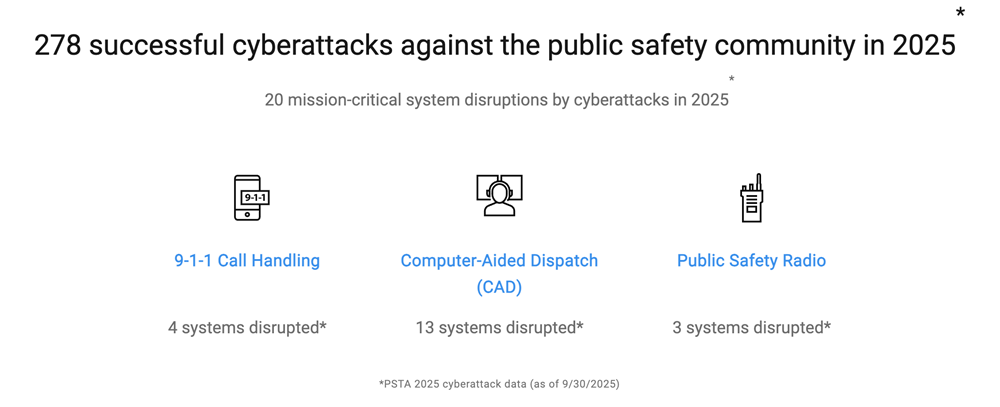This October, as we observe Cybersecurity Awareness Month, the latest quarterly figures from the Public Safety Threat Alliance (PSTA) paint a clear picture of the critical need for a united front against growing cyber threats. The data shows a significant increase in attacks, with a 103 percent increase in successful cyber attacks against public safety agencies in Q3 2025 alone. This brings the total number of attacks so far this year to 278, a number that underscores the accelerating pace of the threat landscape.
Of those, 20 attacks have disrupted mission-critical systems, including 9-1-1 emergency call handling, Computer-Aided Dispatch (CAD) and public safety radio systems. The stakes for public safety agencies are higher than ever, as a single data breach or system outage can have far-reaching consequences. These incidents show a clear trend of attackers targeting critical infrastructure to cause maximum disruption.
The reality of the threat
The data speaks for itself: these cyber attacks aren’t just statistics; they are real-world threats that disrupt mission-critical systems and jeopardize the safety of communities. These disruptions can lead to catastrophic consequences, such as delayed emergency responses, compromised sensitive data following a ransomware attack and potential exposure of confidential information. Every successful intrusion highlights the sophistication of modern threat actors, who continually find new ways to evade detection.
The impact is felt across the entire public safety ecosystem. This year alone, 20 mission-critical system disruptions affected key services when attackers exploited vulnerabilities:
- 9-1-1 Call Handling: Four systems disrupted. When these systems go down, dispatchers can’t properly route or process emergency calls. This creates delays in connecting callers with the help they need.
- Computer-Aided Dispatch (CAD): 13 systems disrupted. First responders rely on CAD to get to the right place at the right time. Disruptions can significantly delay emergency response times and affect coordination between agencies.
- Public Safety Radio: Three systems disrupted. Communications are the lifeline for first responders in the field. When compromised, officers, firefighters and EMS personnel lose critical communication capabilities needed for effective response and coordination.
These aren’t hypothetical scenarios. They’re the harsh reality we face today as cyber threats continue to evolve.
The rise of cyberattacks against public safety continues to grow. The most common threats are phishing attacks, remote access and credential abuse. These attacks can lead to catastrophic disruptions and jeopardize community safety. Attackers are increasingly launching distributed denial-of-service (DDoS) attacks to overwhelm networks, while also orchestrating supply chain attacks to compromise software and hardware before they reach an agency.

Cybersecurity recommendations
To effectively combat these threats, a proactive and multi-layered approach to cybersecurity is essential. Agencies must establish offline backups and practice in restoring affected systems. It is also crucial to prioritize patching internet-facing systems, focusing on vulnerabilities that could allow for remote code execution. A well-rehearsed incident response plan is no longer optional; it is a core requirement for resilience.
Enforcing multi-factor authentication (MFA), especially for internet-facing systems, is a simple yet powerful way to prevent credential abuse. Furthermore, agencies should be aware of connections to external networks and adopt 24/7 monitoring to detect and respond to anomalous activity quickly. Finally, agencies should exercise their cyber incident response plans at least once a year to ensure all stakeholders are aware of their roles during an attack.
A unified defense with the PSTA
These individual efforts are significant, but the most effective defense is a unified one. The PSTA serves as a central hub for sharing actionable intelligence and resources, fostering a “neighborhood watch” approach to public safety networks. By joining forces, we can strengthen our collective defenses and protect the mission-critical systems that keep our communities safe.
Motorola Solutions established the PSTA to combat these very real threats. The PSTA serves as a hub for sharing and analyzing cyber threat information, helping agencies strengthen their defenses against sophisticated attacks. The strength of the PSTA lies in its community, which has grown to over 2,000 member organizations. This significant milestone underscores the profound importance of collective defense against constantly evolving cyber threats, as more members contribute to better threat intelligence and greater security for all.
Membership is no-cost for all public safety agencies and provides access to vital resources, including:
- Actionable threat intelligence and vulnerability alerts.
- Automated threat intelligence feed.
- Dark web monitoring to alert you of compromised credentials.
- Exclusive webinars and training sessions with cybersecurity experts.
The PSTA’s mission is to reduce the cybersecurity burden on public safety agencies, enabling them to focus on their primary mission of protecting and serving the community.
Take action this Cybersecurity Awareness Month
As part of Cybersecurity Awareness Month, we invite you to our Q4 2025 webinar, “Defending the Front Lines: PSTA Member Insights,” on October 23 at 1:00 PM ET. This is an excellent opportunity to learn from peers and experts about current cybersecurity challenges and best practices. Register now to secure your spot!




